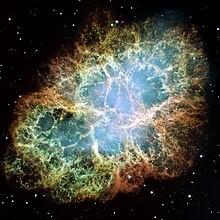
Back Krapnewel Afrikaans سديم السرطان Arabic কৰ্কট নীহাৰিকা Assamese Nebulosa del Cámbaru AST Xərçəng dumanlığı Azerbaijani Крабападобная туманнасць Byelorussian Крабападобная туманнасьць BE-X-OLD Ракообразна мъглявина Bulgarian ক্র্যাব নেবুলা Bengali/Bangla Rakova maglina BS
| Supernova remnant | |
|---|---|
 Hubble Space Telescope mosaic image assembled from 24 individual Wide Field and Planetary Camera 2 exposures taken in October 1999, January 2000, and December 2000 | |
| Observation data: J2000.0 epoch | |
| Right ascension | 05h 34m 31.94s[1] |
| Declination | +22° 00′ 52.2″[1] |
| Distance | 6500±1600 ly (2000±500[2] pc) |
| Apparent magnitude (V) | +8.4 |
| Apparent dimensions (V) | 420″ × 290″ |
| Constellation | Taurus |
| Physical characteristics | |
| Radius | ~5.5 ly (~1.7[3] pc) |
| Absolute magnitude (V) | −3.1±0.5[c] |
| Notable features | Optical pulsar |
| Designations | Messier 1, NGC 1952, Taurus A, Sh2-244[1] |
The Crab Nebula (catalogue designations M1, NGC 1952, Taurus A)[4] is a supernova remnant and 'pulsar wind nebula' in the constellation of Taurus. The nebula was observed by John Bevis in 1731; it corresponds to a bright supernova recorded by Chinese and Islamic astronomers in 1054. In 1840, astronomer William Parsons gave it the name it has today.[5]
The nebula is about 6,500 light-years (2 kpc) from Earth. It has a diameter of 11 ly (3.4 pc) and expands at a rate of about 1,500 kilometers per second. It is part of the Perseus Arm of the Milky Way Galaxy.
At the center of the nebula lies the Crab pulsar, a neutron star (or spinning ball of neutrons), 28–30 km across,[6] which emits pulses of radiation from gamma ray bursts to radio waves with a spin rate of 30.2 times per second. The nebula was the first astronomical object identified with a historical supernova explosion.[7]
The nebula acts as a source of radiation for studying celestial bodies between it and us. In the 1950s and 1960s, the Sun's corona was mapped from observations of the Crab's radio waves passing through it, and in 2003, the thickness of the atmosphere of Saturn's moon Titan was measured as it blocked out X-rays from the nebula.
The cloudy remnants of SN 1054 are now known as the Crab Nebula. The nebula is also referred to as Messier 1 or M1, being the first Messier object catalogued in 1758.
- ↑ 1.0 1.1 1.2 "M 1". SIMBAD. Centre de données astronomiques de Strasbourg. Retrieved 12 February 2012.
- ↑ Kaplan, David L.; Chatterjee, S.; Gaensler, B. M.; Anderson, J. (2008). "A Precise Proper Motion for the Crab Pulsar, and the Difficulty of Testing Spin-Kick Alignment for Young Neutron Stars". The Astrophysical Journal. 677 (2): 1201–1215. arXiv:0801.1142. Bibcode:2008ApJ...677.1201K. doi:10.1086/529026. S2CID 17840947.
- ↑ Hester, J. J. (2008). "The Crab Nebula: An Astrophysical Chimera". Annual Review of Astronomy and Astrophysics. 46: 127–155. Bibcode:2008ARA&A..46..127H. doi:10.1146/annurev.astro.45.051806.110608.
- ↑ catalogue designations M1, NGC 1952, Taurus A
- ↑ Parsons, William (1844). "Observations on Some of the Nebulae". Philosophical Transactions of the Royal Society of London. 134. fig. 81, plate xviii, p. 321. doi:10.1098/rstl.1844.0012. JSTOR 108366. S2CID 186212669.
- ↑ "Crab Nebula: the spirit of Halloween lives on as a dead star creates celestial havoc".
- ↑ Cite error: The named reference
Mayallwas used but no text was provided for refs named (see the help page).